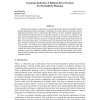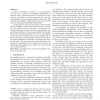39 search results - page 3 / 8 » Learning Probabilistic Relational Planning Rules |
PKDD
2009
Springer
13 years 11 months ago
2009
Springer
Probabilistic relational models are an efficient way to learn and represent the dynamics in realistic environments consisting of many objects. Autonomous intelligent agents that gr...
SOFSEM
2007
Springer
13 years 10 months ago
2007
Springer
In this work we assume that there is an agent in an unknown environment (domain). This agent has some predefined actions and it can perceive its current state in the environment c...
JAIR
2010
13 years 3 months ago
2010
Domain-specific features are important in representing problem structure throughout machine learning and decision-theoretic planning. In planning, once state features are provide...
ICML
2005
IEEE
14 years 5 months ago
2005
IEEE
Many real-world domains exhibit rich relational structure and stochasticity and motivate the development of models that combine predicate logic with probabilities. These models de...
SDM
2010
SIAM
13 years 6 months ago
2010
SIAM
A relational probability tree (RPT) is a type of decision tree that can be used for probabilistic classification of instances with a relational structure. Each leaf of an RPT cont...


